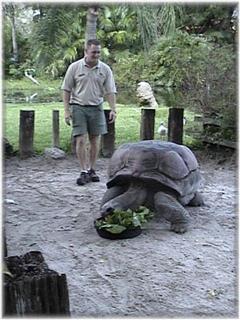Aldabra Giant Tortoise
Giant Tortoise, Aldabra Tortoise Scientific Name: Aldabrachelys gigantea
Wed, 30th April, 2025 - 6:33 am GMT
Sponsor Ads:

Alternative Name
Giant Tortoise, Aldabra Tortoise Scientific Name: Aldabrachelys giganteaBasic Info
The Aldabra Tortoise is very large. Females often weigh 350 pounds or more, while males average around 550 pounds. They are usually black or dark gray in color and have a rounded shell, or carapace.
Health
Breeding The Aldabra Tortoise breeds between February and May. Between four and twenty-five eggs are laid by the female, although half of each clutch is usually infertile. The eggs hatch after 98 to 200 days of incubation. The fertility rate of the clutch is much lower in captivity, and eggs are often infertile.Habitat
Lives on the Aldabra Atoll, an island north of Madagascar on the coast of KenyaBehavior
The Aldabra Tortoise is one of the largest tortoise in the world. They are an endangered species and are not commonly kept as private pets, although the Aldabra Tortoise is a common tortoise in zoos and wildlife preserves. Attempts are being made to reintroduce Aldabra Tortoises to small islands. The only remaining species of four types of giant tortoises that once lived in the Indian Ocean, the Aldabra Tortoise lives on the Aldabra Atoll, an island north of Madagascar on the coast of Kenya. It is estimated that there are about 150,000 Aldabras living on the Aldabra Atoll, the largest known colony of giant tortoises in the world. It is found on three of the four islands that make up the Aldabra Atoll. The majority of the population is concentrated on Malabar and Grande Terre. Malabar consists of dense vegetation at the center of the island, but the tortoises reside on the more open, coastal areas that consist of grasslands and shrubs. The Aldabras are grazers and feed primarily on grasses, herbs, and sedges. Only two seasons exist on the Aldabra Atoll: the monsoon season, from November to April, and the dry season, from May until October. The tortoises choose their habitats based on where the premium growth is after the rainy season. Many tortoises migrate closer to the turf during the rainy season, but when the rainy season is over, the tortoises left on the coast have a high fatality rate due to lack of shade and dehydration. Very little is known about appropriate housing of Aldabra Tortoises in captivity. When attempts are made to breed captive Aldabras, the eggs are more often than not infertile.Origin
Aldabra AtollHistory
In the 1600s, Mauritius was colonized. Settlers from this country often traveled to the Seychelles islands, where four types of giant tortoises were common. The settlers often removed or killed the tortoises, resulting in the extinction of three of the four species. The only remaining species is the Aldabra Tortoise, which lives on a decidedly unfriendly island 700 miles away from Mauritius. The other three species were extinct by 1840. The Aldabra Tortoise was designated an endangered species in the late 1800s, one of the first animals ever to gain this protection. In 1971, an international airport was opened on the Seychelles Islands and it quickly became a popular tourist attraction. Because of the drastically improved economy, the Seychelles Government and the Royal Society of London decided to build a daughter colony in 1977. In 1978, 101 Aldabra Tortoises were tagged and monitored. Ninety-five of the tortoises were eventually released on Curieuse, an island near Mahe, that was designated a National park in 1979 by the Seychelles government. The tortoises adapted well to the island, but a follow up study conducted in 1986 by the Zoological Society of London found some disturbing things. For example, tourists were allowed to roam free on the island and often stood on the tortoises for pictures, which damaged the tortoises. They also left behind litter, hazardous to the tortoises and destroyed nesting areas. The researchers were able to find less than half of the tortoises that had originally been introduced to the island, and the number of hatchlings was very small. While they estimated that 400 tortoises should exist by that time, only 102 were found. They believe that poaching, theft and predation by feral cats and rats is the main cause of the high mortality rate. The most dangerous predator for the babies, are giant crab, which dig into the nests for the eggs. The society hopes to improve the conditions, with either more supervision or a well-managed tortoise nursery. In some areas such as Curieuse, tourists are still allowed to roam free near the tortoises. The good news is that today, because of the level of protection that the Seychelles government has instituted, Aldabra populations are growing. The Aldabra Tortoise was classified as Geochelone gigantea, today it is more frequently classified as Aldabrachelys gigantea and less frequently as Dipsochelys elephantina.Common Foods
Sulcatas are herbivores and, in the wild, get most of their food from dried grasses and leaves.Sponsor Ads:
Troutman's Programming Law: #2 Not until a program has been in production for at least six months will the most harmful error then be discovered.
Aldabra Giant Tortoise
Coded by: BGID® | ALL RIGHTS RESERVED Copyright © 2000-2025
Disclaimer | Privacy | Report Errors / Contact | Credits
















